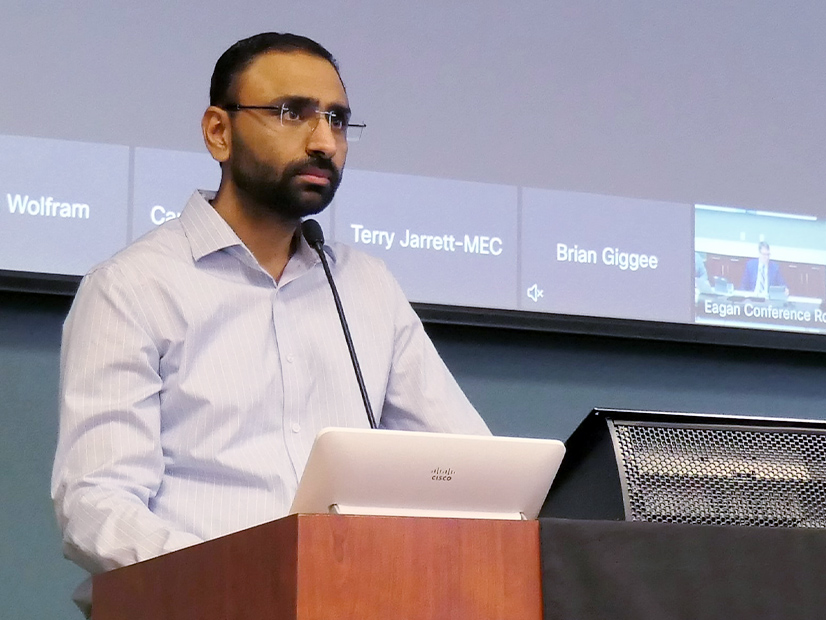CARMEL, Ind. — MISO and SPP said Thursday during their annual issues review that they plan to treat Joint Targeted Interconnection Queue (JTIQ) projects as large generator interconnection projects when allocating costs.
The RTOs have proposed allocating 90% of the portfolio’s costs to interconnecting generators and the remaining 10% to their load. SPP’s load will be responsible for 71% of costs, and MISO will shoulder the remaining 29%.
The JTIQ study completed early last year resulted in five projects on the RTOs’ seam that should help reduce congestion and allow additional resources, primarily wind farms, to interconnect with their systems. The portfolio has an estimated cost of $1.06 billion. (See MISO, SPP Propose 90-10 Cost Split for JTIQ Projects.)
Sumit Brar, reliability analysis lead for MISO long-range planning, said the grid operators will not begin additional JTIQ studies unless the first portfolio has secured enough generation to cover most or more of its costs. Future studies will be conducted on a five-year horizon.
MISO expects the first JTIQ portfolio to support up to 28 GW of interconnecting generation on both sides of the seam.
MISO stakeholders expressed worry that the necessary amount of generation may drop out of the two IC queues, leaving load to handle the bag of costs. Some have also said a 90% cost assignment to interconnecting generation might not be fair.
They asked whether the RTOs might consider adding a cost cap on the per-megawatt charge or enact protections when generation requests drop out of the queue.
“Now, there will be dropouts, so we expect that,” MISO Director of Resource Utilization Andy Witmeier said, adding that the RTO expects it will take “a few queue cycles” to get the lines nearly funded.
Witmeier said it’s “unrealistic” to assume that the grid operators won’t have enough willing generation developers to fully fund the projects.
“Eventually, enough generators will sign up, sign [generator interconnection agreements] in the region,” he said.
The RTOs are proposing that generation be on the hook for a JTIQ per-megawatt cost when a project has a greater than 5% distribution factor on one or more facilities in the affected system and a greater than 1-MW impact on “at least one” JTIQ line.
Steelhead Americas’ Adam Solomon said the threshold was “ridiculously low” when compared to the large interconnection projects in the MISO queue.
MISO and SPP said they don’t plan an interregional planning study this year, saying their plates are full memorializing the targeted market efficiency projects (TMEPs) work and preparing for an expected FERC notice of proposed rulemaking on interregional transfer capability. MISO said its planners are also working on the second tranche of its long-range transmission plan.
The grid operators are required to undertake a coordinated system plan every other year. Last year, the two performed a TMEPs study that failed to identify any small interregional projects. (See MISO, SPP Unable to Find Smaller Joint Tx Projects.)
Basin Electric Power Cooperative had asked the RTOs to study constraints in the Dakotas, and Ameren has requested an examination of chronically congested 161-kV lines and a transformer linked to a 345-kV line in Missouri.
DOE Funding for JTIQs Won’t Affect Cost Allocation
MISO said Tuesday that potential Department of Energy funds will not affect a planned cost-sharing plan for the JTIQ projects.
The grid operators are collaborating with the Minnesota Department of Commerce and the Great Plains Institute to apply for funding from the DOE’s Grid Resilience and Innovation Partnerships (GRIP) program. (See DOE Opens Applications for $6B in Grid Funding.)
The program requires that states affected by a project make the application process. Great Plains is organizing stakeholders and coordinating the multistage GRIP application process.
Brar said states with a JTIQ project are all involved. Funding will be granted to states based on the percentage of projects located within their boundaries.
The organizations sent a concept letter to the DOE earlier in January. The DOE will inform applicants by Feb. 24 whether their projects are sufficient enough for a full application that would be due May 19. Approved GRIP projects could potentially be awarded a 50% project match. (See SPP MOPC Briefs: Jan. 17-18, 2023.)

